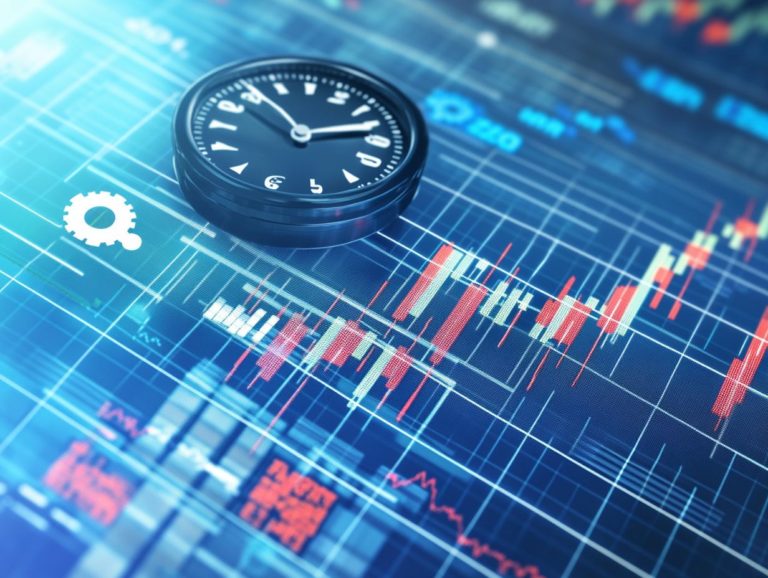What is Technical Indicator Analysis?
Technical indicator analysis is an essential tool for traders navigating the complexities of financial markets with confidence.
By leveraging various indicators such as trend, momentum, and volatility you can gain valuable insights into price movements and identify potential trading opportunities.
This article delves into the different types of technical indicators, offers guidance on interpreting their signals, and highlights their role in shaping effective trading strategies.
This article also covers the limitations of these indicators, ensuring you have a well-rounded understanding before making trading decisions.
Embrace the potential of technical analysis on your trading journey!
Contents
- Key Takeaways:
- What is Technical Indicator Analysis?
- Types of Technical Indicators
- Interpreting Technical Indicators
- Using Technical Indicators in Trading
- Limitations of Technical Indicator Analysis
- Frequently Asked Questions
- What are some common technical indicators used in analysis?
- How does technical indicator analysis differ from fundamental analysis?
- What are the benefits of using technical indicator analysis?
- Are there any limitations to technical indicator analysis?
- Is technical indicator analysis suitable for all types of financial assets?
Key Takeaways:

- Technical indicator analysis helps you make informed trading decisions based on mathematical calculations.
- The three main types of indicators are trend, momentum, and volatility, each offering unique insights.
- These indicators are helpful but not foolproof. Always consider their limitations alongside other analyses.
What is Technical Indicator Analysis?
Technical Indicator Analysis is crucial for understanding price movements in financial markets. It utilizes a range of tools and techniques to interpret historical data and market sentiment. This form of analysis is vital for traders, helping them navigate the intricate landscape of stocks and bonds and make informed investment choices.
By assessing various indicators, including Moving Averages and the Relative Strength Index, you can develop a thorough understanding of market dynamics. This allows you to pinpoint entry and exit points while considering chart patterns and trading volume.
Ultimately, this analysis helps you spot buy and sell signals that can boost your trading success.
Types of Technical Indicators
Technical indicators can be divided into various types, each serving a distinct purpose. Among these, trend indicators help identify the direction of price movements; momentum indicators assess the speed at which prices change; and volatility indicators measure market fluctuations.
Each category is essential for analyzing market conditions effectively and making informed decisions based on the signals presented.
Trend Indicators
Trend indicators are critical tools in technical analysis that help you pinpoint the direction and strength of price trends in financial markets. One commonly used indicator is the Moving Average, which smooths out price data to reveal underlying trends over specific timeframes. Understanding trend strength is crucial, as it directly influences your decision-making regarding entry and exit points.
Alongside Moving Averages, the Average Directional Index (ADX) is another vital tool for assessing trend strength, whether the trend is upward or downward. A rising ADX indicates increasing trend strength, providing essential guidance on when to enter or exit positions.
By effectively combining these indicators, you can create a comprehensive view of market conditions, allowing you to anticipate price movements more accurately and refine your trading strategies. Mastering the interpretation of these signals not only hones your analytical skills but also significantly enhances your chances of making informed, profitable decisions.
Momentum Indicators
Momentum indicators are vital tools in your technical analysis. They help you gauge the speed and strength of price movements, giving you valuable insights as a trader.
The Relative Strength Index (RSI) is a key momentum indicator that helps identify overbought and oversold conditions. Understanding this allows you to make informed decisions based on market psychology.
By grasping the concept of momentum, you can spot potential reversal points in price movements. Other noteworthy momentum indicators, like the Moving Average Convergence Divergence (MACD) and Stochastic Oscillator, serve a vital role in this analytical framework.
These indicators capture prevailing market sentiment and provide insight into the psychology influencing traders’ actions whether it s the thrill of fear of missing out (FOMO) or the anxiety of panic selling.
As you analyze these indicators, you can quickly pinpoint optimal entry and exit points, refining your strategies and enhancing your risk management. Ultimately, mastering the use of momentum indicators enables you to stay ahead of market trends, guiding you toward more successful trades.
Volatility Indicators

Volatility indicators are critical for you as a trader. They help you grasp the extent of price fluctuations in financial markets, which can greatly influence your trading strategies.
By analyzing these variations, you can more accurately assess the potential for swift price movements in various trading environments. Take Bollinger Bands, for example. They consist of a middle band that reflects a moving average, flanked by two outer bands that adjust according to market volatility, offering you valuable insight into whether conditions are overbought or oversold.
The Average True Range (ATR) is another essential tool in your arsenal. It measures market volatility by comparing current price ranges to historical data. Together, these indicators are crucial for risk management, enabling you to make informed decisions that align with your financial objectives while dynamically responding to shifts in market sentiment.
Interpreting Technical Indicators
Interpreting technical indicators involves a careful method that demands a deep understanding of how to read and apply trading signals for well-considered choices. You will evaluate various indicators to identify optimal entry and exit points, while also analyzing price trends and market sentiment.
Mastering this skill allows you to deftly navigate the complexities of financial markets. This significantly enhances your ability to respond to market movements with precision and confidence.
Understanding Signal Strength
Understanding signal strength is vital for you as a trader. This is especially true when using technical indicators to assess market conditions and inform your investment decisions.
Signal strength helps you determine whether a trend is strong enough to warrant action. It guides you in interpreting market sentiment and adjusting your strategies accordingly. Mastering this concept enables you to navigate price movements more effectively, ultimately enhancing your overall trading performance.
Signal strength plays a crucial role in crafting effective trading strategies, offering insights into the sustainability of price movements. For example, when you observe a high Relative Strength Index (RSI), it suggests that an asset may be overbought, hinting at a potential reversal or pullback. Conversely, a low RSI might indicate an oversold condition, nudging you to consider buying opportunities.
Grasping these indicators informs your decisions and showcases your psychological resilience to market fluctuations. As market sentiment evolves, being attuned to signal strength enables you to maintain emotional discipline, allowing you to navigate through volatility with confidence.
Using Technical Indicators in Trading
Effectively utilizing technical indicators is essential for you as a trader aiming to build strong trading plans that elevate your decision-making process.
By integrating a range of technical indicators, you can analyze price trends, assess market sentiment, and pinpoint trading signals that guide your entry and exit points.
This approach helps you adapt to the ever-changing landscape of financial markets, ultimately enhancing your trading outcomes.
Incorporating Indicators into Trading Strategies
Incorporating indicators into your trading strategies means blending various trading tools to create a cohesive framework for effective market condition analysis. You can enhance your trading prowess by using chart patterns along with indicators like Moving Averages and the Relative Strength Index. This enables you to assess support and resistance levels while crafting strategies that align with your trading goals.
By taking a well-rounded approach, you bolster the reliability of your trading signals, ultimately helping you develop effective entry and exit points.
Integrating these indicators allows you to pinpoint key market trends and reversals, significantly improving your timing and decision-making. For instance, merging Fibonacci retracement levels a tool that traders use to identify potential reversal points with Moving Averages provides a clearer perspective on potential support zones, greatly enhancing your entry strategies.
Examining historical case studies where traders have successfully employed integrated methods can yield valuable insights. These real-world examples demonstrate how recognizing specific chart patterns like double tops or bottoms alongside other indicators can lead to remarkably improved trade outcomes.
Limitations of Technical Indicator Analysis

While technical indicator analysis offers valuable insights for your trading decisions, it s crucial to acknowledge its limitations, especially regarding accuracy and reliability. Market psychology plays a significant role in price movements, often resulting in unexpected outcomes that technical indicators cannot foresee.
By recognizing these limitations, you can approach technical analysis with a balanced perspective and incorporate additional strategies to effectively mitigate risks.
Factors that May Affect Accuracy
Several factors can significantly affect the accuracy of your technical analysis, shaping how you interpret price movements and market trends. Market sentiment, economic indicators, and unforeseen events can introduce volatility that technical indicators may not fully capture. Recognizing these factors is essential for refining your strategies and enhancing your predictive accuracy.
For instance, sudden shifts in market sentiment, triggered by news events or changes in economic data, can lead to price movements that stray from historical patterns. Relying solely on technical indicators during such volatile times can be misleading. By integrating a broader analysis that includes an understanding of macroeconomic conditions and social sentiment, you can better anticipate potential shifts.
Adapting your strategies may involve setting wider stop-loss margins or employing a combination of technical and fundamental analysis to mitigate risks tied to unexpected market movements.
Summary of Key Points
Technical analysis involves a rich array of tools and techniques that enable you to understand market dynamics and make informed trading decisions.
By leveraging these tools effectively, you can identify trends and shifts in market behavior, which is essential for crafting robust trading strategies. The variety of indicators at your disposal like trend indicators that help pinpoint market direction, momentum indicators that measure price movement strength, and volatility indicators that assess market fluctuations are crucial for navigating trading complexities.
Stay alert! Understanding the limitations intrinsic to technical analysis, such as external market influences and the potential for misinterpretation, can greatly affect the accuracy of your predictions. Ultimately, assimilating this knowledge enhances your trading outcomes.
Frequently Asked Questions
What is Technical Indicator Analysis?
Technical indicator analysis is a method used by traders and investors to analyze the historical price movements of a financial asset to predict future price trends.
Explore these insights further and apply what you’ve learned to boost your trading success!
What are some common technical indicators used in analysis?

Common technical indicators include moving averages and the Relative Strength Index (RSI). Moving averages smooth out price data, while RSI measures the speed of price changes.
How does technical indicator analysis differ from fundamental analysis?
Technical analysis focuses on price movements and patterns. In contrast, fundamental analysis considers financial statements and economic conditions.
What are the benefits of using technical indicator analysis?
Technical indicator analysis allows traders to make informed decisions based on historical price trends. This can lead to more profitable trades, especially when timely decisions are made.
Are there any limitations to technical indicator analysis?
Technical indicator analysis relies on past data and can t predict sudden market events. It works best when combined with other analysis methods.
Is technical indicator analysis suitable for all types of financial assets?
Technical indicator analysis is commonly used for stocks and currencies. It’s also applicable to commodities and cryptocurrencies.
Explore technical analysis today to unlock new trading opportunities!






